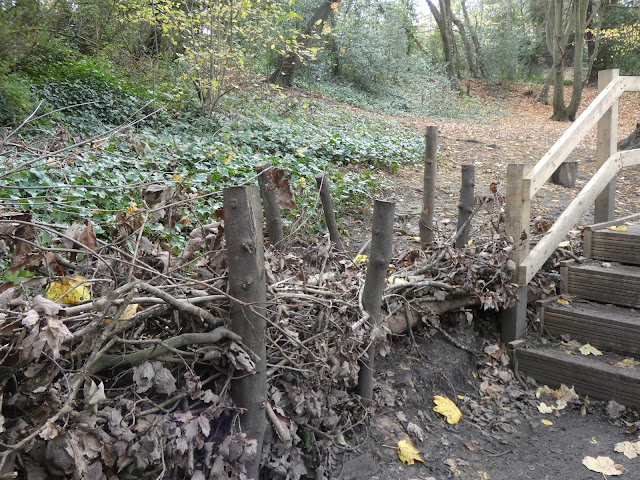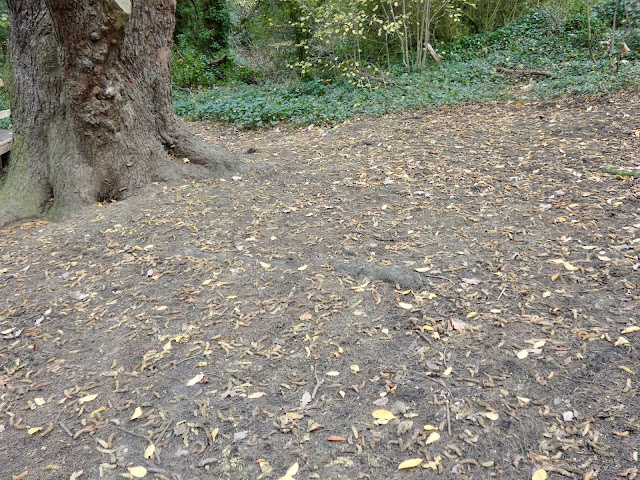Protecting our Wood
The trees making up our woodland are a mixture of native species and garden survivors from Victorian development.
Before the expansion of London, the Wood was used extensively to provide raw materials for ship-building on the Thames and timber for general building in domestic and agricultural use. As such, many species were coppiced to maintain a steady and reliable supply of wood. Species suitable for this type of woodland management include ash, hornbeam and hazel. When a tree is coppiced, its main trunk is cut down to the ground and soon new side shoots will emerge to grow upwards. Depending on the size and age of this growth, the shoots can be harvested for various uses such as canes, posts and palings. Coppicing can extend the life of the tree enormously and the resulting patchwork of light and dark increases biodiversity. Without coppicing, the woodland will grow old and degenerate, species diversity declines and ecological health suffers. Unfortunately, it is a practice that has been in a long decline which has accelerated enormously since the Second World War.
Today, in the wood, volunteers coppice holly mainly for its hard straight wood, which is excellent for making fencing posts. Being evergreen, dense clumps of holly block out light to the woodland floor, excluding ground cover, so thinning it allows regeneration of woodland species such as the native bluebell and the wood anemone. It also allows the saplings of native species like oak to stand a better chance of growing to maturity.
Barriers
Which bring us to the question as to why some areas of the wood have been fenced in and other areas have been lined with "dead-hedging". Some people think there is too much fencing in the wood and some think there should be none at all. It is worth remembering that only about 5% of the wood's area has been fenced in. There are very good reasons as to why some areas have had access restricted.
a) The railway cutting.
The railway cutting south of Cox's Walk Bridge has been fenced in to protect species which are sensitive to trampling. One species, the sweet woodruff is found here and is rare in the area.
 |
| Sweet woodruff |
b) The wild garlic patch
One of the longest established fenced areas is just to the left of the railway track, as it approaches the tunnel. This area contains a large patch of wild garlic (ransoms) which is sensitive to trampling. Also, there have been cases of people breaking into the area to forage for this plant. However, it is illegal to take wild plants from their natural location, it causes damage to the plant and others in the vicinity and it robs everyone else of the enjoyment of seeing and smelling the garlic when in full bloom.
Wild garlic
c) Recovery zones
Areas of fencing like that to be seen near the folly have been put in to allow the woodland floor to recover from extensive trampling. Without this, species like native bluebells and wood anemones would be unable to survive. It is hoped also to provide a quiet sanctuary to encourage the return of hedgehogs to the wood.
d) Pond areas
The small pond by the glade is fenced off as a safety measure but also to protect its banks and aquatic plants from disturbance. Just over the border into Dulwich Wood, the Dewey Pond has a platform for pond dipping when school parties can be supervised and discover the life of the pond.
However, not all areas are fenced off and other methods are used to help encourage people to keep to the paths.
Dead-hedging.
As parts of both Sydenham Hill and Dulwich Woods were both developed for housing in the Victorian era, garden remnants and plant escapees are common. Some of the plants can be a real problem, such as Japanese Knotweed (thankfully not a problem in the Wood) and Cherry Laurel and Spotted Laurel. Cherry laurel is highly invasive, its roots even release a cyanide compound into the soil, which along with the dark evergreen foliage, prevent any other ground cover plants from surviving. The plants grow to medium tree height and until their removal, they created a dark and forbidding woodland. Hard work by London Wildlife Trust staff and their volunteers has made good progress in tackling this problem and large swathes of cherry laurel have been cut down, allowing the regeneration of native species like oak, bluebells and anemones. The cut material is put to good use. The thicker branches are cut to around 2m in length and one end sharpened to a point. Then these are driven into the ground in pairs, along the edge of a path for instance. The space in between is filled with the foliage and smaller branches, so providing a natural barrier. Over time, this will decay and form a habitat for a diverse range of creatures, from insects to small mammals like wood mice.
 | ||||
| Dead-hedge freshly made from cherry laurel |
Routeways
Board-walk.
 |
| The cedar of Lebanon this spring, before the board-walk was installed. |
Recently, a board-walk has been built to protect the cedar of Lebanon in the upper part of the wood. This magnificent tree is a garden remnant and was once in the grounds of The Hoo, one of the largest of the Victorian mansions built along Sydenham Hill, after the Crystal Palace was relocated to Upper Sydenham. This contemporary engraving shows the back garden and what is likely to be our cedar when it was very young, seen just to the left of the main path.
 |
| Public Domain, https://commons.wikimedia.org/w/index.php?curid=9836452 |
After the Second World War, the large mansions were deteriorating, being far too large for post-war needs. As their leases ran out, they were demolished, most having gone by the 1960's. The last one, Beechgrove, was demolished in 1983. Now the sites of these houses and their gardens have reverted to woodland. Close inspection of the wood near Sydenham Hill will reveal the remains of terraces and steps, foundations and cellars, now hidden in the undergrowth as nature reclaims the area.
 | ||
| These steps came down from the terrace of 87, Sydenham Hill to gain access to the tennis court.The retaining wall of the terrace can be seen in the top left . |
 |
| 1951 survey showing the main features mentioned. |
Despite its impressive size, the cedar has been showing signs of stress and some branches have had to be removed. The stress is caused by compaction of the soil around its roots, resulting from thousands of people walking around the base of the tree. As the soil becomes compacted, rainwater runs off more quickly and the tree finds it difficult to obtain sufficient amounts as a result. Also, nutrient levels are reduced. The Wildlife Trust had the boardwalk built to encourage people to keep to the path and allow the ground around the base of the tree to recover. A dead-hedge has been incorporated to help achieve this.
 | |
| Soil compaction and erosion exposing the tree's roots can be seen clearly in this photo. |
 |
| The dead-hedge here is intended to encourage people to use the board-walk and allow the recovery of the soil around the cedar. It doesn't help, however, when material is removed from the dead-hedge. |
Conservation in the woods has to attempt to strike a balance between the desire of people to have the freedom to roam wherever they like and the need to protect the ecosystem. First and foremost, the wood is a nature reserve so there will be the need to restrict access to certain area in order to ensure the ecology there is protected.









Great blog lots of information about history and ecology of the site
ReplyDelete